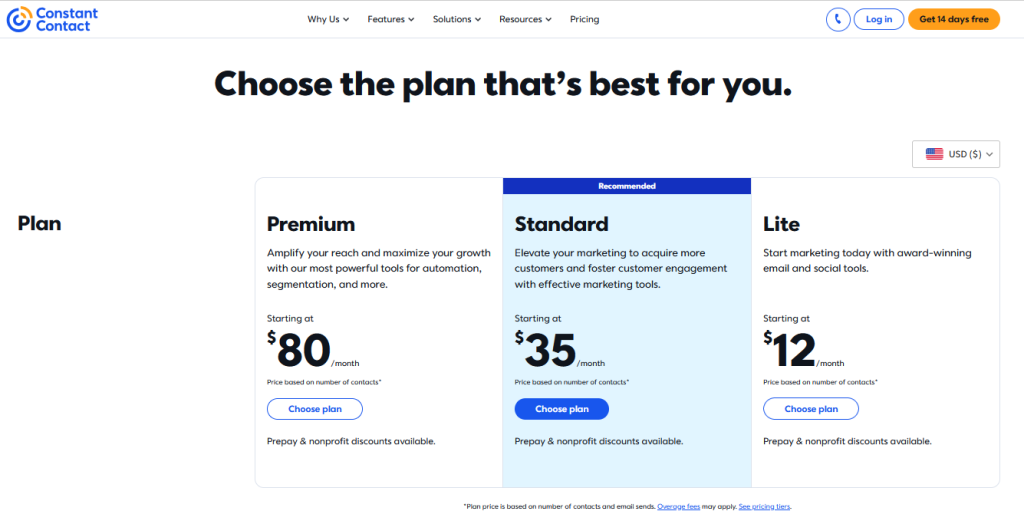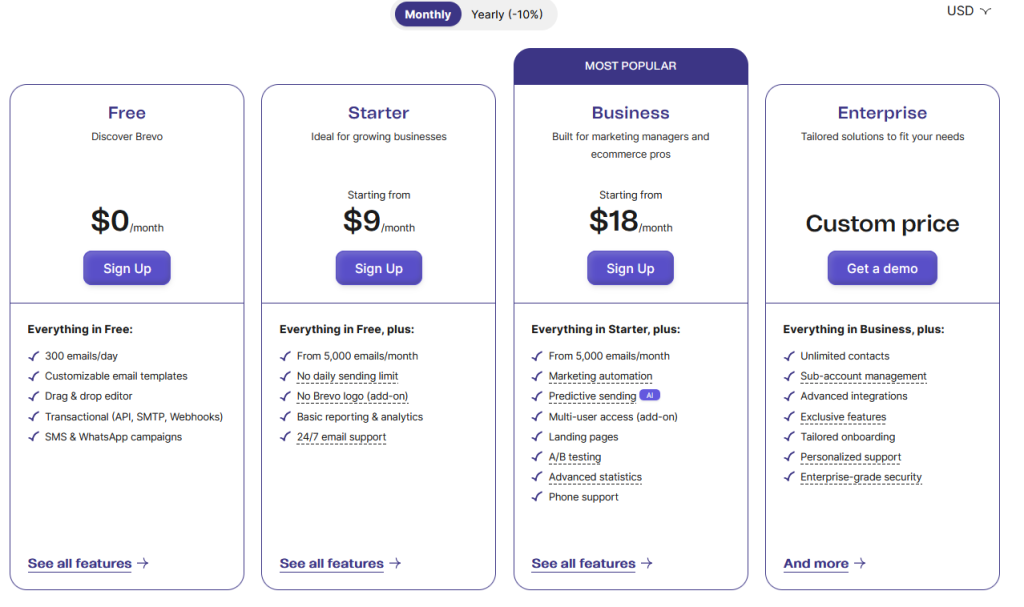- Home
- Comparing Alternatives
- Best MailerLite Alternatives [ ...

✨ Key takeaways:
⭐ MailerLite is a budget-friendly email marketing software tool that fits best for small businesses, early-stage startups, bloggers, and non-profits.
⭐ Leading MailerLite alternatives in 2025 include Constant Contact, Klaviyo, GetResponse, Brevo, and Flodesk.
⭐ Each EMS has its pros and cons and shall be assessed based on users’ business goals and budgets.
⭐ When deciding on an EMS platform, it is important to consider your growth stage, technical needs, and the kind of user experience your team prefers.
I remember speaking with a small business owner last fall — someone who had been using MailerLite for years without ever questioning it. “It’s always just worked,” she said, “but now I need better automation and more detailed segmentation.” This isn’t a rare case in which a business outgrows its provider and starts looking for the one with more—or just a different—set of features.
According to our research, the best MailerLite alternatives in 2025 are Constant Contact, Klaviyo, GetResponse, Brevo, and Flodesk. Each of these options responds to a different pain point and, thus, targets different user cases. This article offers a comprehensive overview of each platform, including comparisons like MailerLite vs. GetResponse, MailerLite vs. Flodesk, and more, to help you assess what matters most for your particular case.
What Is MailerLite?
MailerLite is an email marketing platform that was founded in 2010 and since then has grown into one of the fastest-growing email automation SaaS platforms. It is considered equally approachable for beginners while offering enough functionality to support the needs of more experienced users. So, what exactly does it offer?
First, users can choose from a variety of professionally designed email templates and customize them with a drag-and-drop editor. The platform supports email automation (including simple drip sequences and behavior-triggered emails) and provides tools for audience segmentation and tagging.
It also includes extras like a landing page builder, pop-up form creator, and even a built-in survey tool. These features allow users to engage their subscriber list through multiple channels.
Pricing

One key aspect of MailerLite’s pricing is that it only charges for active subscribers.
The platform offers a free plan that allows up to 1,000 subscribers and 12,000 emails per month, giving new users a chance to try out many features at no cost.
Paid plans are also budget-friendly—the Growing Business tier starts at around $13/month for 1,000 subscribers (with unlimited emails). The Advanced plan will cost users $27/month for 1,000 subscribers and an additional set of features, such as an AI writing assistant, enhanced automation, and others.
For very large lists or special requirements, MailerLite also offers high-volume enterprise options that add features like dedicated IPs and deliverability consultation.
Pros:
✅ Its free plan and low-cost tiers provide excellent value.
✅ Ease of use and clean design, which help reduce the learning curve for new users.
✅ Good deliverability rates, partially due to a strict account approval process that keeps spammers out.
Cons:
🔻 It lacks certain advanced capabilities, such as reporting or built-in CRM features.
🔻 Free plan users cannot access MailerLite’s full template gallery (they must build emails from scratch).
🔻 Provides support mainly via email or chat—there’s no phone support.
MailerLite vs. Constant Contact
Constant Contact is a platform with a long-established reputation that offers not just email marketing but also extras like event management tools and social media promotion features that have been added to the platform over the years.
Among its distinct features are a template library with numerous designs, a drag-and-drop email editor, contact list management with tagging, and basic automation. One notable strength is its event marketing integration—you can create and promote events, send invitations, and manage RSVPs within one platform. So, if event promotion is important, Constant Contact could be a better MailerLite alternative.
The platform has also expanded into multi-channel marketing: it offers social media advertising tools and has recently introduced SMS marketing capabilities.
Pricing

Constant Contact does not offer a permanent free plan; instead, new users can start with a 14-day free trial to test the service.
The Lite plan starts at roughly $12 per month for up to 500 subscribers. As your email list grows, so does the cost.
Constant Contact’s Standard plan adds more advanced features like automated email series, polls, surveys, and event marketing tools and is priced at $35 per month. For the Premium plan with a full set of features, users will pay $80 per month.
When comparing MailerLite vs. Constant Contact, it’s clear that Constant Contact is generally more expensive for the same list size, and some features that come standard with MailerLite are only available on higher-tier Constant Contact plans.
Pros:
✅ Comprehensive support and training resources
✅ Event management and social media tools
✅ Integrated SMS option for a wider reach
Cons:
🔻 More expensive than MailerLite for comparable list sizes
🔻 Some advanced features require higher-tier plans
🔻 No permanent free plan—only a 14-day free trial
MailerLite vs. Klaviyo
Klaviyo is a platform known for its powerful integration with online store platforms (like Shopify, WooCommerce, Magento, and others) and its focus on data-driven marketing.
Klaviyo provides a large library of email templates and a flexible drag-and-drop editor. It also stands out with its automation and targeting: users can build sophisticated automation workflows triggered by a wide range of events. Klaviyo’s tight integration with e-commerce stores enables a dynamic product feed. This means you can automatically include product recommendations in emails tailored to each recipient based on their browsing and buying behavior.
Additionally, Klaviyo offers advanced reporting and analytics that provide deep insight into campaign performance and customer behavior. Marketers can track metrics like lifetime value, purchase frequency, and even use predictive analytics (a premium Klaviyo feature).
On top of that, Klaviyo offers built-in SMS marketing capabilities and AI for optimizing campaigns.
Pricing

In the MailerLite vs. Klaviyo comparison, MailerLite offers a more generous free plan, while Klaviyo’s free tier is quite limited—only allowing up to 250 contacts and 500 total email sends per month before requiring a paid upgrade.
Klaviyo’s pricing is based on the number of contacts in your account, and it scales as you add more subscribers. For example, 1,000 contacts in Klaviyo cost about $30 per month on the Email plan (with 10,000 emails per month). For the same number of contacts and an increased number of emails and SMS/MMS credits per month, users will pay $45.
Pros:
✅ Deep integration with e-commerce platforms
✅ Strong reporting and predictive analytics features
✅ Includes SMS marketing in the same platform
Cons:
🔻 Higher entry price point compared to MailerLite
🔻 Limited free plan (250 contacts and 500 emails/month)
🔻 Steeper learning curve for new marketers
MailerLite vs. GetResponse
GetResponse positions itself as more than just an email tool—it’s a platform that combines email marketing with tools for building landing pages, creating conversion funnels, hosting webinars, and even managing e-commerce marketing campaigns.
One of its standout features is its webinar hosting integration—GetResponse allows you to host webinars and online meetings directly on the platform. This is great for marketers who use webinars for lead generation or customer engagement, as you don’t need separate webinar software. Additionally, there’s a landing page and website builder included, so you can create dedicated pages for your campaigns without any external tool.
GetResponse has also kept up with trends by introducing an AI-powered email content generator and an online course builder. Of course, standard features like a drag-and-drop email designer, a large template library, automation capabilities, A/B testing, detailed email analytics, and integrations (with e-commerce platforms, CRMs, etc.) are all present.
In summary, GetResponse offers one of the widest feature sets in the industry, functioning as a marketing hub for email, web, and webinar campaigns.
Pricing

While GetResponse does not have a free plan, the platform offers a 30-day free trial during which users can access all features. The Starter plan starts at around $19/month for 1,000 subscribers.
If you want more advanced features, you’d need to choose a higher-tier plan. The Marketing Automation (Marketer) plan starts at about $59/month for 1,000 subscribers, adding advanced automation workflows and additional integrations.
Above that is the Creator plan, which will cost you around $69/month for 1,000 subscribers, which unlocks the full feature set.
Pros:
✅ Built-in webinar hosting and online course tools—rare among email tools
✅ Offers conversion funnels and chat functionality for lead generation
✅ AI-powered content generation and subject line suggestions
✅ Generous 30-day free trial with access to premium features
Cons:
🔻 Pricing is significantly higher as your list grows or you need advanced tools
🔻 Some users may find the interface and feature set overwhelming
🔻 Many top features (like webinars) are available only on higher-tier plans
MailerLite vs. Brevo (Sendinblue)
Brevo is a platform known for its affordability and overall ease of use. It has a drag-and-drop editor, a library of modern templates, and supports all the essentials like scheduling, list segmentation, and autoresponders. It also includes fairly advanced marketing automation capabilities—you can create workflows with multiple steps and conditions.
Additionally, Brevo has an integrated CRM system. This isn’t a full-blown CRM, but it allows small sales teams to manage contacts, track deals, and integrate that with email campaigns—something MailerLite does not offer.
Brevo also supports SMS marketing, letting you send text message campaigns or automated SMS. And for those with websites, Brevo includes web forms, Facebook Ads integration, and even a live chat widget that you can add to your site and respond to chats from within Brevo.
Pricing

In the MailerLite vs. Brevo comparison, one major difference lies in pricing models—while MailerLite charges based on the number of subscribers, Brevo allows unlimited contacts and charges based on the number of emails sent per month, offering up to 10,000 emails for free.
The platform has the Free plan with unlimited subscribers on your list as long as you don’t send more than 300 emails per day.
When you need to send more emails, you move to a paid plan based on email volume. The entry-level paid tier is the Starter plan, which begins at $9/month for 5,000 emails per month. Some features like advanced statistics are not included on this plan unless you buy an add-on.
That’s why many businesses go for the next tier to get rid of those limitations. The mid-tier is the Business plan, which starts at $18/month for 5,000 emails.
Beyond that, Brevo offers the Enterprise plan for very large senders or those needing dedicated infrastructure.
Pros:
✅ Includes transactional email support (SMTP, API) at all levels
✅ Strong automation features, even in lower plans
✅ Integrated CRM, live chat, and SMS marketing
Cons:
🔻 Advanced statistics and branding removal require the Business plan
🔻 The Free plan has daily sending limits (300 emails/day)
MailerLite vs. Flodesk
Flodesk is a newer player in the email marketing space that has quickly gained popularity, especially among creators, bloggers, and small business owners who prioritize design.
It offers a minimalist, design-centric interface that lets users craft visually beautiful emails without a steep learning curve. The platform comes with 60+ elegant email templates, which users can customize with a drag-and-drop editor, adding images, videos, and unique fonts.
Flodesk supports basic email automation; however, the triggers for automation are intentionally kept simple. In addition to emails, Flodesk provides forms and landing pages: you can create sign-up forms for your site or use Flodesk’s landing page templates to capture subscribers.
One recent feature Flodesk introduced is Flodesk Checkout (available on its higher plan), which lets users sell digital products or services directly through Flodesk by creating checkout pages and processing payments via Stripe.
Flodesk, being a younger platform, still focuses primarily on the core email experience: it doesn’t have some advanced features like detailed analytics or a CRM integration.
Pricing
Flodesk’s pricing is as distinctive as its design focus. Rather than tiered pricing or subscriber-count packages, Flodesk offers two flat-rate plans that do not change based on your number of subscribers or emails sent. As of 2025, Flodesk’s plans are Professional at $38/month and Advanced at $64/month.
Flodesk also offers a free plan, which provides users with options to create and design but not with actual email marketing—for that, paid plans are required.
Pros:
✅ Beautiful, modern templates perfect for creatives and visual brands
✅ Extremely intuitive and aesthetically pleasing interface
✅ Built-in checkout feature for selling digital products
Cons:
🔻 No free plan for sending emails
🔻 Lacks advanced automation and detailed analytics features
🔻 Not suited for complex segmentation or behavior-based triggers
🔻 Email support only—no live chat or phone help
To Sum Up
Choosing the best MailerLite alternative in 2025 ultimately depends on your specific needs and priorities. While MailerLite remains a reliable and budget-conscious option, it may not meet the growing needs of modern businesses.
Each platform reviewed above offers a distinct approach to email marketing for good reason, since different tools serve different needs. So, take advantage of free trials, test interfaces, and pay attention to usability, as the best MailerLite alternative is the one that makes your marketing easier.



